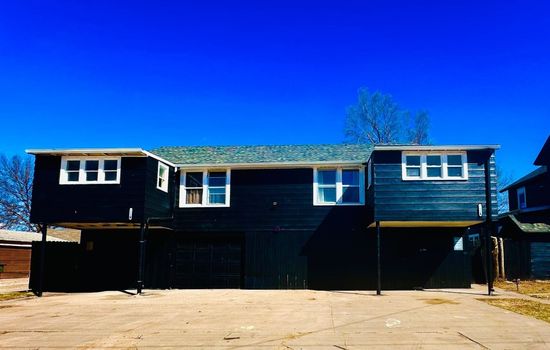The visitor center at Nicodemus National Historic Site is open from 9 AM to 5 PM, central time, every day except Tuesdays, Wednesdays, Thanksgiving Day, December 25, and January 1.
There is no entrance fee to visit Nicodemus National Historic Site. It is free year-round.
From Hays, take Highway 24 east, pass through Hill City, and arrive at this historic enclave, a testament to pioneer spirit and freedom’s pursuit.
Free parking on-site, including accessible parking. No overnight parking. No specific restrictions for RVs or motorcycles mentioned. No parking fees.
Accessibility & permits
Emergency
- Cell service availability:Partial
Information not accurate?
Help us improve by making a suggestion.
Nicodemus National Historic Site, located in the vast and rolling plains of Kansas, is a poignant testament to the pioneering spirit of African Americans who ventured west in the late 19th century. Founded in 1877 by newly freed slaves seeking freedom and opportunity, Nicodemus stands as the oldest and only remaining Black settlement west of the Mississippi River.
As you step into this historic town, the landscape unfolds with a mix of resilient prairie grasses and the remnants of a once-thriving community. The site is dotted with historic buildings, each telling a story of determination and resilience. The St. Francis Hotel, the AME Church, the First Baptist Church, and the Nicodemus School District No. 1 building are among the structures that stand as silent witnesses to the town’s vibrant past.
Visitors can immerse themselves in the history through self-guided or ranger-led tours, which provide a deep dive into the lives of the settlers who built homes, businesses, and a community from scratch. The visitor center, housed in the former Township Hall, offers a rich tapestry of exhibits and a compelling video featuring descendants of the original settlers.
Despite the town’s decline after the railroad bypassed it in 1888, Nicodemus retains an aura of community and hope. Today, with only about 20 residents, the site is more a testament to history than a bustling town, yet it remains an inspiring and educational destination. Special events, including guided tours and interpretive programs, bring the site to life, especially during the spring and summer months when the prairie blooms with wildflowers and the skies are a brilliant blue.
For those seeking a more immersive experience, the surrounding area offers a glimpse into rural Kansas life, with nearby artisan towns and local outfitters providing opportunities to explore the broader region. Nicodemus National Historic Site is not just a place to visit; it is an experience that grounds you in the history and spirit of those who dared to dream of a better life.
- Area (mi²)
- 1
- Annual visitors
- 7 535
- Established year
- 1877
Top 3 Facts about Nicodemus National Historic Site
The town was named after a legendary African-American slave from an abolitionist song, and it covers an area where the population drastically declined from a vibrant community to about 20 people today, after the railroad bypassed it in 1888.
This historic site, set amidst the expansive Kansas prairie, is home to a diverse array of wildlife. Ray-finned fishes inhabit the nearby waters, while amphibians and reptiles thrive in the surrounding habitats. The skies are filled with a variety of birds, and mammals such as deer and prairie dogs roam the open spaces. Unique flora includes native grasses and wildflowers that bloom vibrantly across the landscape, creating a picturesque backdrop for this significant cultural and natural preserve.
Surrounded by the expansive Great Plains, this historic site is set amidst a landscape of rolling prairies and open fields, punctuated by trees and shrubs that serve as windbreaks. The area is characterized by its flat grid configuration and the presence of locally quarried limestone structures, with the nearby Solomon River flowing gently through the plain, its waters reflecting the serene beauty of the prairie landscape.
Family programs
- Junior Ranger
- Ranger-led Tours
- Self-guided Tours
- Workshops & Hands-on Activities
Travel Tips
Plan Ahead
Visit in spring for mild weather and the annual Homecoming Celebration. Allow a few hours to explore historic buildings and trails. Start at the visitor center, wear comfortable shoes, and bring water and snacks as options are limited. Plan for rest stops during your walk.
Pack Appropriately
Pack layers for variable weather, sturdy hiking boots, and a waterproof tent if camping. Bring a multi-tool, headlamp, and refillable water container. Check the season for specific gear like warm jackets or insect repellent.
Respect Wildlife
Maintain a safe distance from wildlife, at least 25 yards. Never feed or approach animals. Control pets and dispose of waste properly to preserve the natural habitat. Be mindful of seasonal weather and respect the land as you would your own. Leave the area as you found it.
Stay Informed
Stay on marked trails, avoid ledges and water areas, and check weather conditions. Follow park signs and rules. For emergencies, call 911 or park authorities at the provided contact number. Stay informed to ensure a safe adventure.
Seasons
In spring, temperatures range from 50s to 70s Fahrenheit, with mild weather and blooming wildflowers. Visit in May for the Spring Chautauqua, featuring living history performances under the big tent, and the annual Emancipation Celebration, a vibrant homecoming event with a parade. Ideal for outdoor enthusiasts and history buffs.
Visit in July for the Homecoming Celebration, a vibrant mix of family reunion and county fair, with temperatures in the 80s and 90s. Warm summer days filled with music, games, and historical events make this a must-visit time.
Visit in fall for mild temperatures (50s-70s°F) and the annual Emancipation/Homecoming Celebration in late July, though the fall season itself is marked by crisp air and golden prairies. Ideal for a serene, historic immersion.
Visit in winter (Dec-Feb) for a serene, snow-covered landscape with temperatures often below 30°F. Crisp air and fewer crowds enhance the historical ambiance, though some facilities may be closed on Tuesdays and Wednesdays. A tranquil, educational experience amidst the winter stillness.
Information not accurate?
Help us improve by making a suggestion.
Where to stay
Frequently Asked Questions
Ready to dive into what Nicodemus National Historic Site has to offer? Let’s tackle some of the burning questions you might have as you plan your visit!
-
The closest city to the site is not a major city, but rather the town of Nicodemus itself, as it is located in rural northwestern Kansas between Hill City and Stockton.
-
Dogs must be on a leash in the town but are not allowed inside the Township Hall (visitor center). Pets are welcome in town on a leash. Service animals are an exception and are allowed in the visitor center.
-
Parking is free at this site. There are no specific restrictions mentioned for different types of vehicles such as campers, motorhomes, or trailers.
-
Nicodemus was founded in 1877 by newly freed slaves from the South who sought refuge and freedom in Kansas. The town, located in Graham County, Kansas, was established by pioneers like Reverend Simon Roundtree and represents the involvement of African Americans in the homesteading movement across the Great Plains. It symbolizes the vision, tenacity, and faith of African Americans who left the Jim Crow South to build a community on free soil, and it preserves the history of one of the largest towns in the area founded by African Americans during the Reconstruction era.






